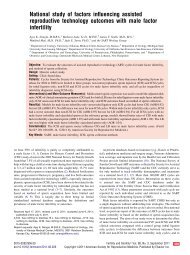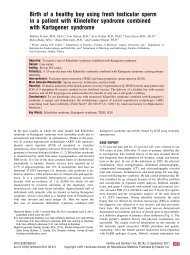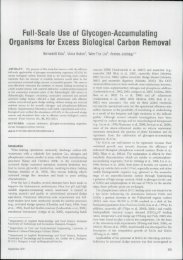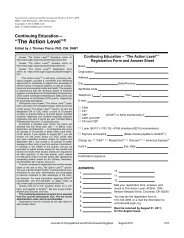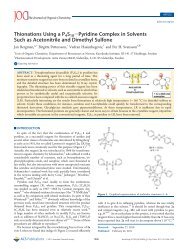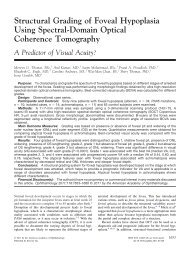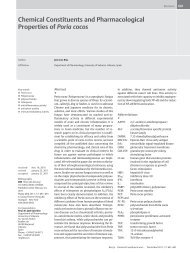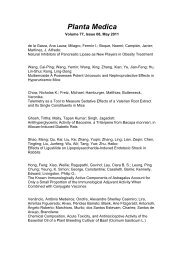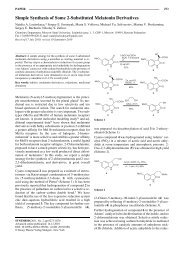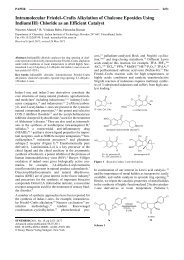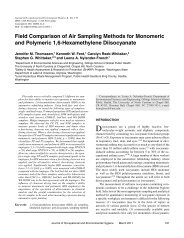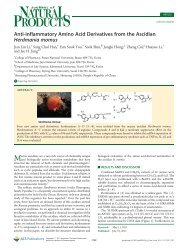You also want an ePaper? Increase the reach of your titles
YUMPU automatically turns print PDFs into web optimized ePapers that Google loves.
718 J.-L. Zhu et al. PAPER<br />
18<br />
a, b<br />
82% over 2 steps<br />
O<br />
(<strong>±</strong>)-3<br />
Scheme 5 Reagents <strong>and</strong> conditions: (a) TBAF (5.0 equiv), THF,<br />
r.t., 3 h; (b) PDC (2.0 equiv, based on 24), CH2Cl2, r.t., 2 h.<br />
In summary, we have accomplished the total synthesis <strong>of</strong><br />
1 <strong>and</strong> 2 in 13 steps through a novel synthetic approach. Although<br />
the ultimate synthesis did not strictly follow the<br />
initially designed scheme, our original goals <strong>of</strong> using the<br />
Diels–Alder reaction to construct the A-ring <strong>and</strong> the reductive<br />
alkylation <strong>of</strong> the Diels–Alder adduct to create the<br />
spiro quaternary center with the suitable functionalities<br />
for accessing the B-ring have been well realized. In the<br />
synthetic sequence, some intermediates were produced as<br />
the isomeric mixtures, but the separations <strong>of</strong> them were<br />
shown to be unnecessary since all <strong>of</strong> the isomers could be<br />
eventually converted into either <strong>of</strong> the targets. In comparison<br />
with the previously reported syntheses (overall<br />
yields: 0.31% 6 <strong>and</strong> 4.51% 7 for 1, 2.12% 6 <strong>and</strong> 0.45% 7 for<br />
2, respectively), the current study did not result in a significant<br />
improvement on the overall yields <strong>of</strong> 1 (0.85%) <strong>and</strong><br />
2 (1.74%), but the synthetic route developed by us appears<br />
to be more general <strong>and</strong> the generality has been demonstrated<br />
by the ready achievement <strong>of</strong> (<strong>±</strong>)-majusculone (3)<br />
from the intermediate leading to 1 <strong>and</strong> 2. The application<br />
<strong>of</strong> the same strategy for the syntheses <strong>of</strong> other members <strong>of</strong><br />
chamigrene family is the focus <strong>of</strong> our ongoing studies.<br />
Unless otherwise noted, all starting materials <strong>and</strong> reagents were<br />
purchased from commercial suppliers <strong>and</strong> used without further purification.<br />
THF was distilled from sodium-benzophenone; toluene,<br />
benzene, CH 2Cl 2, <strong>and</strong> DMF were distilled from CaH 2 before use.<br />
TLC analysis <strong>and</strong> preparative TLC were performed on Macherey-<br />
Nagel DC-Fertigplatten. Durasil-25 UV 254 glass-backed plates, <strong>and</strong><br />
visualized by UV, or KMnO 4 or I 2 treatment. All <strong>of</strong> the products<br />
were purified by flash chromatography on Merck Kieselgel 60 (Art.<br />
9385) (230–400 mesh) or neutral aluminum oxide. IR spectra were<br />
recorded on a Jasco FT/IR 410 spectrometer. NMR spectra ( 1 H, 13 C,<br />
DEPT, NOESY) were recorded on a Bruker Avance DPE-400 or a<br />
Bruker Avance DPE-600 spectrometer using CDCl 3 or C 6D 6 as solvent.<br />
High-resolution mass spectra (HRMS) <strong>and</strong> low-resolution<br />
mass spectra (LRMS) were recorded on a Finnigan/Thermo Quest<br />
MAT 95XL spectrometer in a fast atom bombardment (FAB) model.<br />
Ethyl 2-Cyano-3-methylbut-2-enoate (4)<br />
This known compound was prepared by a modified procedure as<br />
follows. LiBr (7.82 g, 0.09 mol) <strong>and</strong> molecular sieves 3Å (300 mg)<br />
were added to a mixture <strong>of</strong> ethyl cyanoacetate (2.0 g, 0.018 mol)<br />
<strong>and</strong> acetone (60 mL). The suspension was refluxed for 18 h, cooled<br />
to r.t., filtered, <strong>and</strong> concentrated in vacuo. The residue was diluted<br />
with EtOAc (300 mL), washed with H 2O (2 × 50 mL) <strong>and</strong> brine (50<br />
mL), <strong>and</strong> concentrated. The crude mixture was subjected to chromatographic<br />
purification on silica gel (hexane–EtOAc, 20:1) to<br />
yield 4 (1.82 g, 66%).<br />
Synthesis 2011, No. 5, 715–722 © Thieme Stuttgart · New York<br />
O<br />
4-(tert-Butyldimethylsilyloxy)-1-cyano-2,6,6-trimethylcyclohex-3-enecarboxylic<br />
Acid Ethyl Ester (6) <strong>and</strong> 1-[(1R*,2S*,6S*)-<br />
4-(tert-Butyldimethylsilyloxy)-2,6-dimethylcyclohex-3enyl]ethanone<br />
(11)<br />
To a flame-dried 100 mL round-bottom flask were added anhyd<br />
ZnCl 2 (804 mg, 5.9 mmol) <strong>and</strong> anhyd toluene (20 mL). The resulting<br />
suspension was stirred under a N 2 atmosphere for 20 min before<br />
treating with a solution <strong>of</strong> 4 (904 mg, 5.9 mmol) in anhyd toluene<br />
(4 mL). After stirring for an additional 30 min, a solution <strong>of</strong> diene<br />
5 10 (5.85 g, 29.5 mmol) in anhyd toluene (8 mL) was added to the<br />
mixture. The mixture was then stirred at 80 °C for 20 h, cooled to<br />
r.t., <strong>and</strong> diluted with EtOAc (120 mL). The solution was successively<br />
washed with H 2O (2 × 30 mL) <strong>and</strong> brine (20 mL), dried<br />
(Na 2SO 4), filtered, <strong>and</strong> concentrated under reduced pressure. Chromatographic<br />
purification <strong>of</strong> the crude residue on silica gel (hexane–<br />
EtOAc, 100:1, 60:1, <strong>and</strong> 40:1) afforded 11 11 (500 mg, generated<br />
from 0.6 out <strong>of</strong> 5 equiv <strong>of</strong> 5) as a colorless sticky oil, followed by 6<br />
(1.7 g, 82%) as a mixture <strong>of</strong> two isomers (50:50).<br />
6<br />
IR (neat): 2960, 2931, 2857, 2242, 1739, 1671, 1463, 1363, 1259,<br />
1207, 838, 781 cm –1 .<br />
1H NMR (400 MHz, CDCl3): d (isomer 1) = 4.57 (br s, 1 H), 4.35–<br />
4.16 (m, 2 H), 3.04–2.95 (m, 1 H), 2.42 (br d, J=17.5 Hz, 1 H),<br />
1.76 (d, J=17.5 Hz, 1 H), 1.33 (t, J=7.2 Hz, 3 H), 1.18–1.05 (m,<br />
9 H), 0.90 (s, 9 H), 0.15 (s, 3 H), 0.14 (s, 3 H); d (isomer 2) = 4.51<br />
(br s, 1 H), 4.35–4.16 (m, 2 H), 2.90–2.82 (m, 1 H), 2.41 (d, J=17.3<br />
Hz, 1 H), 1.74 (d, J=17.3 Hz, 1 H), 1.30 (t, J=7.1 Hz, 3 H), 1.24<br />
(s, 3 H), 1.16–1.05 (m, 6 H), 0.90 (s, 9 H), 0.14 (s, 3 H), 0.13 (s, 3<br />
H).<br />
13C NMR (100 MHz, CDCl3): d (isomer 1) = 167.7, 148.7, 117.6,<br />
105.6, 62.4, 58.9, 43.0, 37.6, 33.4, 27.1, 25.6, 22.0, 18.2, 17.9, 14.2,<br />
–4.3, –4.6; d (isomer 2) = 165.9, 149.3, 119.8, 103.7, 61.9, 57.2,<br />
40.5, 37.0, 35.9, 26.8, 26.0, 25.6, 17.9, 17.3, 14.2, –4.3, –4.5.<br />
HRMS-FAB: m/z calcd for C19H34NO3Si [M + H] + : 352.2308;<br />
found: 352.2298.<br />
11 11<br />
IR (neat): 2958, 2929, 1712, 1673, 1253, 1195, 1180, 838, 779 cm –1 .<br />
1H NMR (400 MHz, CDCl3): d = 4.87 (dd, J=5.2, 1.8 Hz, 1 H),<br />
2.63 (dd, J=12.3, 6.5 Hz, 1 H), 2.51 (dd, J=10.9, 5.3 Hz, 1 H),<br />
2.19–2.10 (m, 1 H), 2.14 (s, 3 H), 2.07 (dd, J=17.0, 5.9 Hz, 1 H),<br />
1.75–1.68 (m, 1 H), 0.92 (d, J=4.7 Hz, 3 H), 0.91 (s, 9 H), 0.80 (d,<br />
J=7.0 Hz, 3 H), 0.13 (s, 3 H), 0.12 (s, 3 H).<br />
13C NMR (100 MHz, CDCl3): d = 210.8, 149.2, 109.1, 57.4, 37.9,<br />
30.7, 30.6, 25.6, 24.8, 19.8, 18.0, 17.9, –4.3, –4.4.<br />
HRMS-FAB: m/z calcd for C16H31O2Si [M + H] + : 283.2093; found:<br />
283.2098.<br />
(1S*,2S*)-1-But-3-enyl-4-(tert-butyldimethylsilyloxy)-2,6,6-trimethylcyclohex-3-enecarboxylic<br />
Acid Ethyl Ester (12)<br />
To a solution <strong>of</strong> 6 (548 mg, 1.56 mmol) in anhyd THF (10 mL) precooled<br />
at –45 °C was added a THF solution <strong>of</strong> lithium naphthalenide<br />
(0.34 M, 16.1 mL, 5.46 mmol) 13 via syringe under the protection<br />
<strong>of</strong> a N2 atmosphere. The resulting dark green solution was stirred at<br />
–45 °C for 30 min <strong>and</strong> successively treated with 4-bromobut-1-ene<br />
(0.63 mL, 6.24 mmol) <strong>and</strong> HMPA (1.09 mL, 6.24 mmol). The reaction<br />
mixture was stirred at r.t. for 12 h, then poured into sat. aq<br />
NH4Cl (10 mL), <strong>and</strong> extracted with EtOAc (2 × 60 mL). The combined<br />
organic extracts were washed with H2O (2 × 15 mL) <strong>and</strong> brine<br />
(15 mL), <strong>and</strong> concentrated. Chromatographic purification <strong>of</strong> the<br />
crude mixture on silica gel (hexane–EtOAc, 100:1) afforded 12 as a<br />
colorless oil (416 mg, 70%).<br />
IR (neat): 2958, 2929, 2902, 2857, 1735, 1673, 1641, 1149, 1130,<br />
989, 939 cm –1 .



